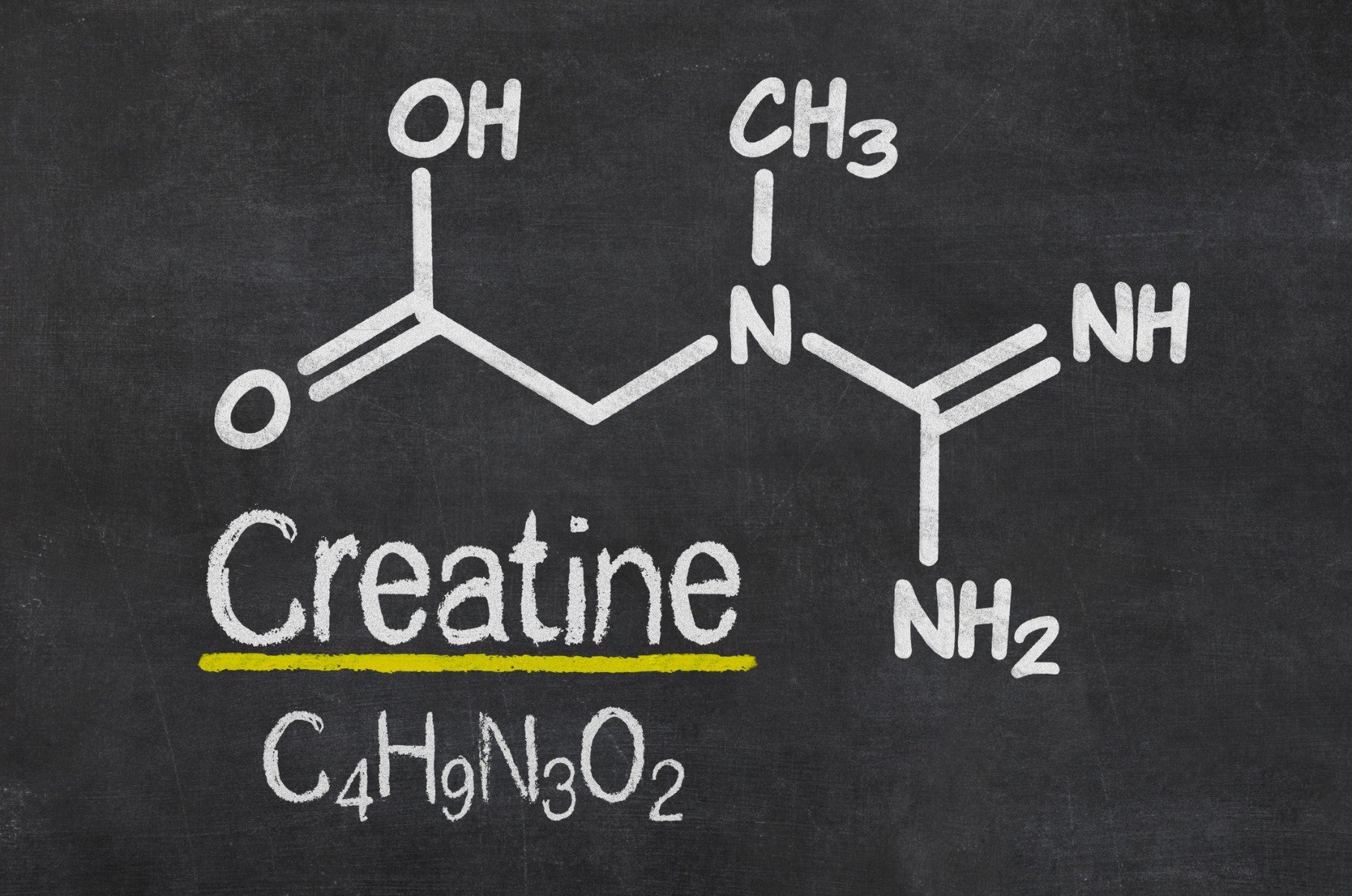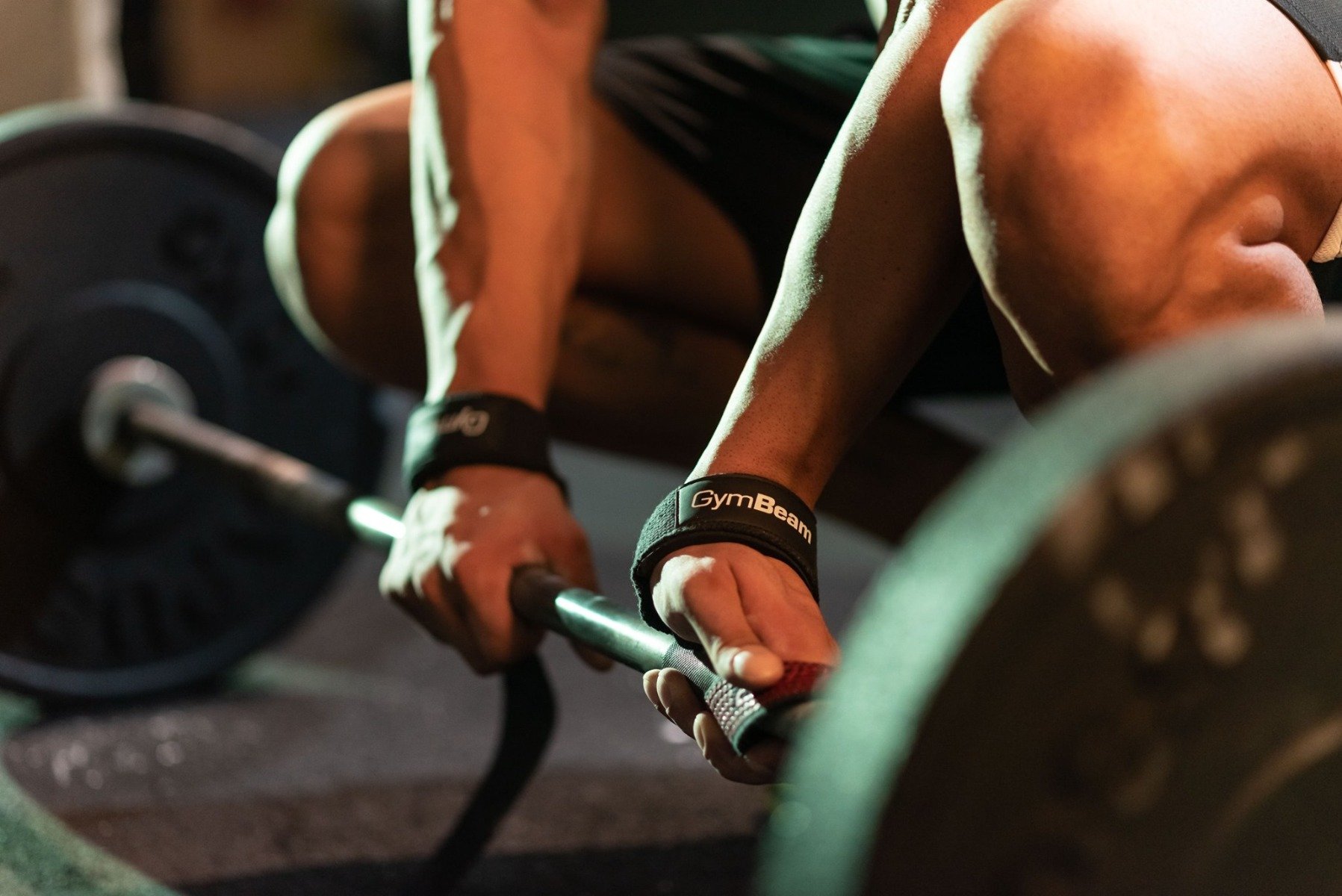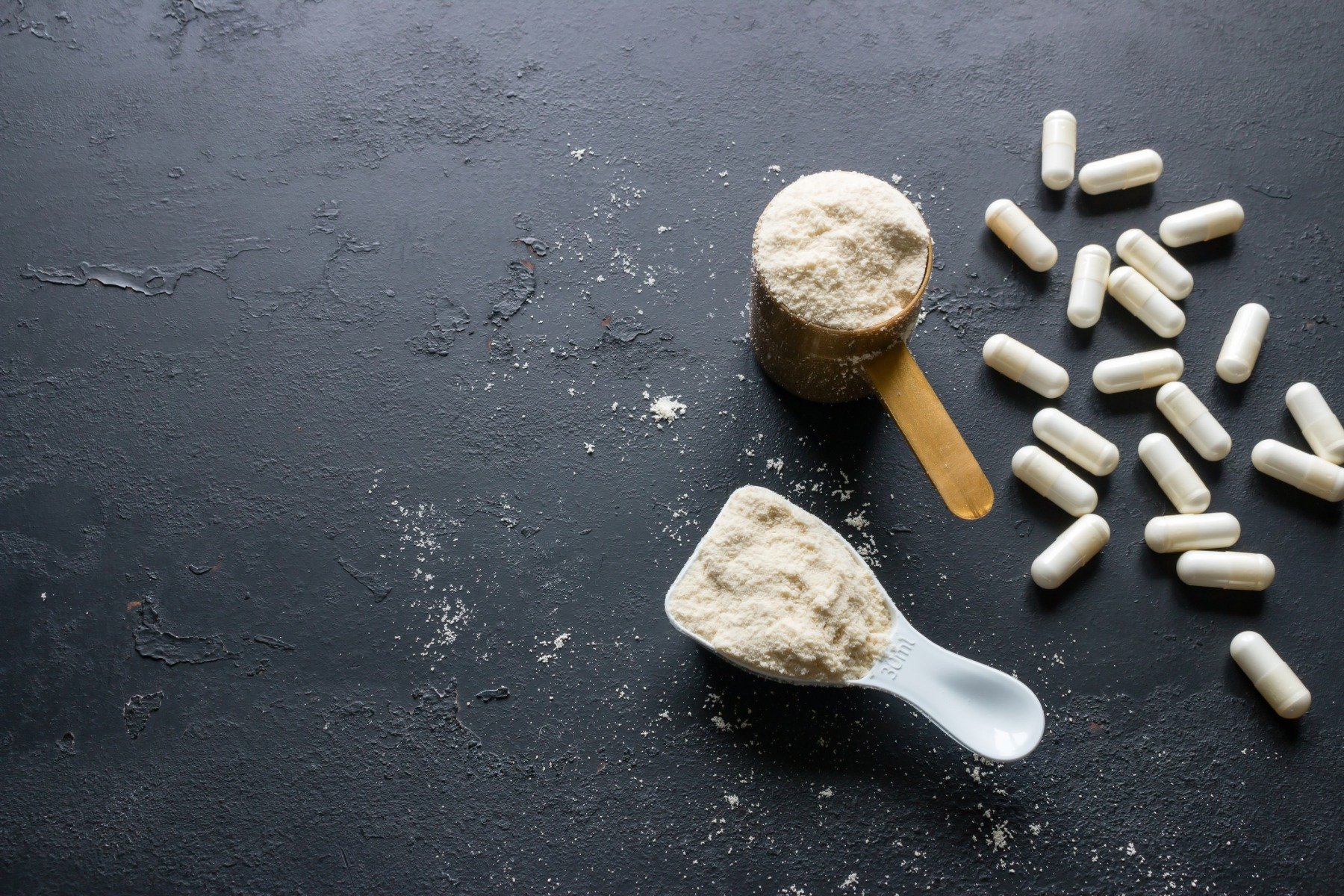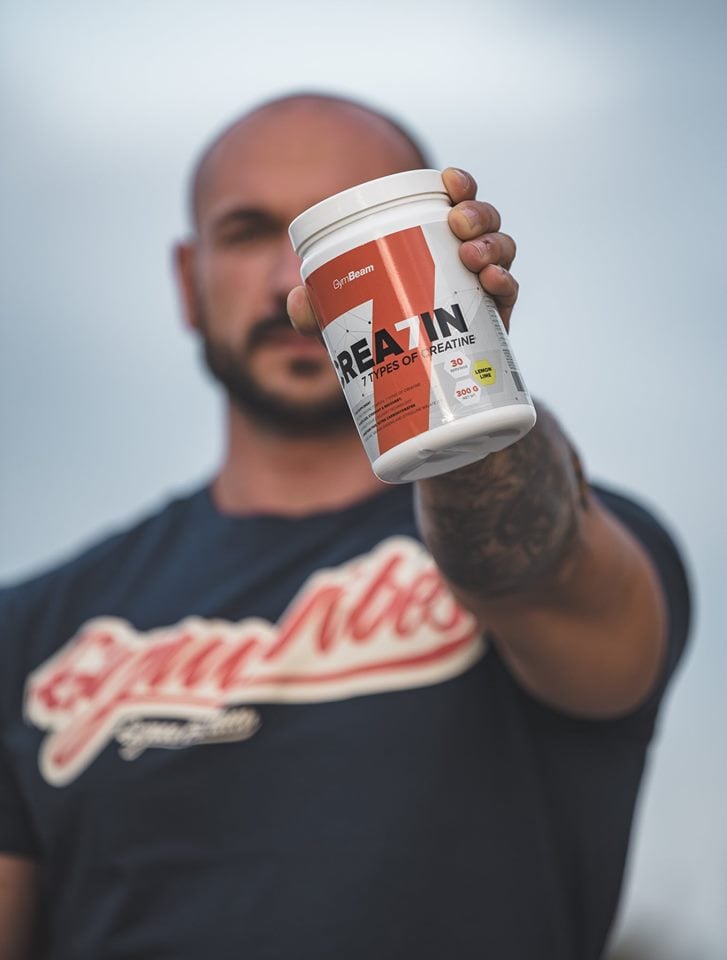Table of Contents
Are you acquainted with various forms of creatine? Do you know in what creatine monohydrate is better than micronized creatine? If not, this article is perfect for you. You will learn everything important about creatine and its types. And in the end, we’ll advise you on what type of creatine is best for you.
What is creatine?
Creatine is one of the most effective and desirable nutritional supplements on the fitness market. This is because of the many benefits it brings to athletes. These include, in particular, significantly improved performance, endurance and explosiveness in intense physical activity. Creatine in the body quickly produces energy during exercise, thus you can train harder. It is also known for its effects on muscle mass growth and strength. [1]
Creatine is an organic molecule that is formed from amino acids in the body. It is mainly produced in the liver and, to a lesser extent, in the kidneys and pancreas. The body usually stores it in the muscles, but it is also transported to the heart and brain. It stores high-energy phosphate groups in the form of phosphocreatine, which are transported to ADP (adenosine diphosphate). It is then transformed into ATP (adenosine triphosphate), which is the primary energy carrier in the body. This role of creatine is particularly important in conditions where the body requires a large amount of energy, for example, in demanding physical or mental activity. [1] [2]
Creatine is also found in some foods, such as beef and fish. However, athletes tend to reach for creatine in the form of nutritional supplements, which are used to quickly and easily supplement the necessary amount of creatine. [1]


Creatine – its effects and benefits
The most important advantage of creatine is its ability to increase strength and performance during training. This benefit of creatine has been very well studied and all results show creatine as a beneficial supplement. By using creatine in combination with regular training, you can promote the growth of pure muscle mass. In many studies, creatine has also been tested for anaerobic sports activity, and here again the results suggest improved performance. [3] [4] [5] [6]
Creatine can theoretically affect cognitive abilities. However, it has not been sufficiently tested to fully confirm this effect.
However, studies have observed a reduction in mental fatigue in mentally demanding activities, sleep deprivation, or traumatic brain injury. At the same time, creatine can improve working memory, but probably only in people with very low creatine levels, such as vegetarians or the elderly. [2]
Creatine has long enjoyed popularity in the fitness enthusiast community because it is a financially acceptable and very effective supplement. It is suitable for beginners, but even top athletes have a word against it. However, you will find various kinds of creatine on the market, which can be very confusing. That’s why we decided to introduce and explain them to you in the following lines.
You might be interested in these products:
Creatine and its forms
Because creatine has multiple forms, we believe it is difficult to choose the right one to help you make your workouts more efficient. Let’s take a look at the most common types of creatine that you can encounter when buying nutritional supplements.
1. Creatine monohydrate
Creatine monohydrate is the most common type of creatine on the market. It is also the form that has been most scientifically researched and tested by experts in many studies. Essentially, this means that most of the scientific effects of creatine have been observed when consuming monohydrate.
Creatine monohydrate consists of creatine molecule and water molecule. However, various methods of preparation are used in its manufacture. If the water molecule is removed, it is anhydrous creatine. Removal of water increases the amount of creatine in the product dose. Anhydrous creatine contains 100% creatine, while classical creatine monohydrate has approximately 90% pure creatine. At the same time, the amount of creatine in the product affects the resulting cost of the nutritional supplement.
Other forms thereof include micronized creatine or mechanically processed creatine having better water solubility. In theory, it is possible that better solubility of the product leads to faster absorption of the substance in the body, but this is not sufficiently confirmed. [9]
Despite these small processing differences, each form of creatine monohydrate is likely to be similarly effective at the same dose. Already 5 to 10 g of creatine monohydrate can lead to increased performance, muscle endurance and muscle size. [10]
2. Creatine hydrochloride
Creatine hydrochloride (HCl) is preferred for its good water solubility. This form results from the binding of creatine to the hydrochloride molecule. One study confirmed that creatine hydrochloride is 38 times more soluble than creatine monohydrate. It is also believed that creatine HCl can be absorbed more effectively in the body. This is why most nutritional supplements containing this type of creatine have less than 1 g of active ingredient per dose. This is a significantly lower portion compared to creatine monohydrate, which is normally given in 5-gram doses. [10]
Unfortunately, there is not yet enough research to confirm these effects on humans. Studies to investigate differences in the effects of creatine HCl and creatine monohydrate are also lacking. However, this does not mean that creatine HCl is not effective. Conversely, it is suitable for people who have creatine monohydrate stomach problems. For creatine hydrochloride, these side effects occur much less. [11] [12]

3. Kre-Alkalyn – buffered creatine monohydrate
Kre-Alkalyn or buffered creatine monohydrate is a form of creatine that contains a slightly basic powder, for example bicarbonate. Manufacturers claim that the addition of this buffer creates a slightly basic compound that can reduce the breakdown of creatine in the stomach and improve its absorption into the muscles. Kre-Alkalyn is sold either alone or in addition to many pre-training stimulants.
Currently, only one study evaluated the effectiveness of this form of creatine. This is a research from 2012 that has seen similar performance improvements between different test groups. The first group received 5 g of creatine monohydrate for 28 days, the other group consumed an equivalent dose of Kre-Alkalyn and the third group received a low dose of 1.5 g of Kre-Alkalyn daily. Groups receiving 5-gram doses started testing with a 7-day saturation phase, using 5 g of creatine 4 times a day. [13]
As a result, all groups significantly improved their muscle mass, fat percentage and strength in legs and hands. Even the group that received lower doses and failed the saturation phase achieved comparable values. However, it is important to note that study subjects receiving creatine monohydrate had an increased muscle creatine content by 50.4% after 28 days, whereas the group receiving Kre-Alkalyn onlyby 27.3%. [13]
This means that you will see the same results when you use Kre-Alkaline and creatine monohydrate. With Kre-Alkalyne, however, a lower dose seems to be sufficient and you do not need a saturation phase. [14]
4. Creatine magnesium chelate
Creatine magnesium chelate is another form of creatine that is produced by binding magnesium to the creatine molecule. Its effects were examined in one study in which experts compared bench pressure and the performance of athletes divided into 3 groups. The first group received creatine monohydrate, the second creatine magnesium chelate and the third group placebo. Both creatine groups improved their performance more than placebo. It follows that creatine magnesium chelate is effective, but no more or less than creatine monohydrate. [15]
Another study from 2003 suggests that creatine magnesium chelate could improve performance without the added weight of water that creatine usually brings. This would be especially useful for athletes trying to keep their weight low. In the meantime, however, we have to take this suggestion with caution, because it has been confirmed by only one study and more in-depth research is needed. [16]

5. Creatine ethyl ester
Creatine ethyl ester is enriched with organic component – ester. Some vendors claim that it is better absorbed and has a longer half-life than conventional creatine monohydrate because it dissolves more easily in fat. Unlike the other types of creatine discussed in this article, ethyl ester is not our favourite. The studies do not agree on the results of its effectiveness.
One research found that 7 weeks of creatine ethyl ester replenishment resulted in a lower ratio of creatine in muscles and blood than by creatine monohydrate. In addition, its use may lead to higher plasma concentrations of the creatinine by-product. Normally, creatinine is excreted from the body as a waste product, but it is not the gentle way for the kidneys. Therefore, the use of creatine ethyl ester is not recommended. [18]
6. Creatine citrate
It is produced by combining creatine with organic citric acid, which is found in citrus fruits and is often used as a natural flavor in nutritional supplements. However, a 2007 study by the International Society of Sports Nutrition found no significant differences in creatine citrate absorption versus creatine monohydrate. However, creatine citrate is more soluble in water, but this is not a reason to think that it is also more effectively absorbed by the human body. [19]
7. Creatine malate
Creatine malate is bound to malic acid, another organic acid commonly found in fruits. Malic acid alone can improve stamina, which led manufacturers to combine it with creatine. [10]
Creatine malate has been verified by several studies suggesting that it improves anaerobic production in judo sprinters and fighters. However, no control research has been conducted comparing creatine malate with monohydrate and placebo. Like creatine citrate, creatine malate is more easily dissolved in water. [20]
8. Creatine nitrate
Creatine nitrate is one of the newer forms of creatine. Manufacturers claim that by binding a creatine molecule to a nitrate molecule, athletes will need a lower dose than creatine monohydrate. But let’s look at the studies.
Research from 2016 noted the effect of creatine nitrate on improving performance. However, the results did not confirm any significant differences between groups of subjects receiving creatine nitrate, creatine monohydrate or low dose creatine nitrate. However, all these groups achieved much better results than the placebo-consuming test group. [17]

9. Creatine gluconate
It is a creatine that is bound by a glucose molecule. There is a theory that creatine gluconate is absorbed more effectively because it is combined with carbohydrate-enriched insulin. However, no study has yet been published to verify this theory. [24]
10. Creatine pyruvate
Creatine pyruvate is produced by the binding of pyruvic acid and is a very interesting combination between individual forms of creatine. However, the studies on its effectiveness are rather mixed. One research showed that it has a better impact on endurance than creatine citrate (which we consider to be an effective type of creatine), but another research found that it did not improve endurance at all. [21] [22]
Some studies have also suggested that, compared to creatine monohydrate, creatine pyruvate results in higher creatine content in the blood. This could mean less creatine in the muscles, which is ultimately not effective. Therefore, this study concluded that creatine pyruvate is unlikely to be more bioavailable than creatine monohydrate. [23]

11. Creatine Alpha-ketoglutarate
It is also known as creatine AKG, which is produced from alpha-ketoglutaric acid and creatine. Theories say that alpha-ketoglutarate, as a glutamine precursor, is better absorbed in the intestine. It also serves to prevent the stomach problems and diarrhoea that bothers some athletes when they consume creatine. In addition, users of creatine AKG claim that it is absorbed more efficiently and results in higher creatine concentrations in muscles than monohydrate. However, there is currently insufficient evidence from relevant studies to support these theories. [10]
12. Multi-component creatine
Multi-component creatine combines multiple types of creatine in one product. It combines the advantages and effects of various forms of creatine into one mixture. For example, it can contain 7 types of creatine as it is in our product Crea7in. Physically active people and athletes will appreciate its benefits such as rapid absorption, muscle growth, more energy and better performance. If you are not able to choose between different types of creatine, multi-component creatine may be the right choice for you.
Creatine and its safety and dosage
Most myths that spread about creatine are not true. However, over years, creatine has lost its reputation because it has been banned as a cancer-causing agent in many countries. Since 2004, however, creatine has been permitted in all countries and is not found on any dangerous supplement list. Yet, even today, some people mistake it as a dangerous kidney-damaging product. However, none of this is true, and many studies have confirmed this. Except for minor digestive problems caused by overuse of creatine, you are not at risk when consuming it. [7] [8]
Suitable daily dose of creatine is 5 g per day. Higher doses of creatine (up to 10 g per day) may be beneficial for people with high muscle mass, high levels of sport activity, or for those people in which 5 grams dose simply has no effect. Athletes are advised to use creatine before and after training. During non-training days, you can take it at any time of the day. Remember that creatine does not work in short-term use. You need to be sustained and consistent in its use. [1] [2]
If you take creatine without enough water, you may experience stomach cramps. Diarrhea and nausea occur if you consume too much creatine. In this case, reduce the dose and spread it out throughout the day, and take your creatine with food and liquids.
What form of creatine is the best?
It is important to remember that creatine monohydrate has the most confirmed evidence supporting its use as a nutritional supplement to improve performance, explosiveness and endurance. However, if creatine monohydrate causes digestive problems, try rather creatine hydrochloride or buffered creatine instead to help reduce stomach problems. Creatine magnesium chelate, on the other hand, can help you increase performance without the added weight of water. However, be aware that the claims of different forms of creatine should be supported by further research.
Tell us about your experience with creatine and what kind of creatine you are using. If this article has provided you with new information, we will be happy if you support it by sharing it.
[1] Kamal Patel - Creatine – https://examine.com/supplements/creatine/
[2] Kamal Patel - Summary of Creatine – https://examine.com/supplements/creatine/#scientific-research
[3] McConell GK, Shinewell J, Stephens TJ, Stathis CG, Canny BJ, Snow RJ - Creatine supplementation reduces muscle inosine monophosphate during endurance exercise in humans. – https://www.ncbi.nlm.nih.gov/pubmed/16331129
[4] Ayoama R, Hiruma E, Sasaki H - Effects of creatine loading on muscular strength and endurance of female softball players. – https://www.ncbi.nlm.nih.gov/pubmed/14767409
[5] Armentano MJ, Brenner AK, Hedman TL, Solomon ZT, Chavez J, Kemper GB, Salzberg D, Battafarano DF, Christie DS - The effect and safety of short-term creatine supplementation on performance of push-ups. – https://www.ncbi.nlm.nih.gov/pubmed/17436778
[6] Smith AE, Fukuda DH, Ryan ED, Kendall KL, Cramer JT, Stout J - Ergolytic/ergogenic effects of creatine on aerobic power. – https://www.ncbi.nlm.nih.gov/pubmed/22131203
[7] Poortmans JR, Francaux M - Adverse effects of creatine supplementation: fact or fiction? – https://www.ncbi.nlm.nih.gov/pubmed/10999421
[8] Groeneveld GJ, Beijer C, Veldink JH, Kalmijn S, Wokke JH, van der Berg LH - Few adverse effects of long-term creatine supplementation in a placebo-controlled trial. – https://www.ncbi.nlm.nih.gov/pubmed/15795816
[9] Ali Zeinolabbedini Hezave, Sarah Aftab, Feridun Esmaeilzadeh - Micronization of creatine monohydrate via Rapid Expansion of Supercritical Solution (RESS) – https://www.sciencedirect.com/science/article/pii/S0896844610001671
[10] Nick English - Ten types of creatine and what they do – https://www.vice.com/en_us/article/ne97ym/ten-types-of-creatine-and-what-they-do
[11] Gufford BT, Sriraghavan K, Miller NJ, Miller DW, Gu X, Vennerstrom JL, Robinson DH - Physicochemical characterization of creatine N-methylguanidinium salts. – https://www.ncbi.nlm.nih.gov/pubmed/22432515
[12] Grant Tinsley - Top 6 types of creatine reviewed – https://www.healthline.com/nutrition/types-of-creatine
[13] Jagim AR, Oliver JM, Sanchez A, Galvan E, Fluckey J, Riechman S, Greenwood M Kelly K, Meininger C, Rasmussen C, Kreider RB - A buffered form of creatine does not promote greater changes in muscle creatine content, body composition, or training adaptations than creatine monohydrate. – https://www.ncbi.nlm.nih.gov/pubmed/22971354
[14] Nick Cocker - Which form of creatine is right for you? – https://www.bodybuilding.com/content/which-form-of-creatine-is-right-for-you.html
[15] Selsby JT, DiSilvestro RA, Devor ST - Mg2+-creatine chelate and a low-dose creatine supplementation regimen improve exercise performance. – https://www.ncbi.nlm.nih.gov/pubmed/15142029
[16] Brilla LR, Giroux MS, Taylor A, Knutzen KM - Magnesium-creatine supplementation effects on body water. – https://www.ncbi.nlm.nih.gov/pubmed/14506619
[17] Elfego Galvan, Dillon K. Walker, Sunday Y. Simbo, Ryan Dalton, Kyle Levers, Abigail O´Connor, Chelsea Goodenough, Nicholas D. Barringer, Mike Greenwood, Christopher Rasmussen, Stephen B. SMith, Steven E. Riechman, James D. Fluckey, Peter S. Murano, Conrad P. Earnest, Richard B. Kreider. - Acute and chronic safety and efficacy of dose dependent creatine nitrate supplementation and exercise performance. – https://jissn.biomedcentral.com/articles/10.1186/s12970-016-0124-0
[18] Mike Spillane, Ryan Schoch, Matt Cooke, Travis Harvey, Mike Greenwood, Richard Kreider, Darryn S. Willoughby - The effects of creatine ethyl ester supplementation combined with heavy resistance training on body composition, muscle performance, and serum and muscle creatine levels. – https://www.ncbi.nlm.nih.gov/pmc/articles/PMC2649889/
[19] Ralf Jager, Roger C Harris, Martin Purpura, Marc Francaux - Comparison of new forms of creatine in raising plasma creatine levels. – https://jissn.biomedcentral.com/articles/10.1186/1550-2783-4-17
[20] Wu JL, Wu QP, Huang JM, Chen R, Cai M, Tan JB. - Effects of L-malate on physical stamina and activities of enzymes related to the malate-aspartate shutlle in liver of mice. – https://www.ncbi.nlm.nih.gov/pubmed/16555951/
[21] Jager R, Metzer J, Lautmann K, Shushakov V, Purpura M, Geiss KR, Maassen N. - The effects of creatine pyruvate and creatine citrate on performance during high intensity exercise. – https://www.ncbi.nlm.nih.gov/pubmed/18269769
[22] Van Schuylenbergh R, Van Leemputte M, Hespel P. - Effects of oral creatine-pyruvate supplementation in cycling performance. – https://www.ncbi.nlm.nih.gov/pubmed/12669262
[23] Ralf Jager, Roger C Harris, Martin Purpura, Marc Francaux - Comparison of new forms of creatine in raising plasma creatine levels. – https://jissn.biomedcentral.com/articles/10.1186/1550-2783-4-17
[24] Green Al, Hultman E, Macdonald IA, Sewell DA, Greenhaff PL - Carbohydrate ingestion augments skeletal muscle creatine accumulation during creatine supplementation in humans. – https://www.ncbi.nlm.nih.gov/pubmed/8944667


Add a comment